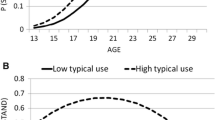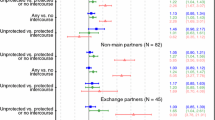Abstract
This study examined longitudinal changes in condom use inconsistency and sexual encounters involving alcohol use and the within-person associations of these two risky sexual behaviors with other personal and contextual factors. Data were drawn from a sample of college students who completed surveys on four occasions across 3 years and included 317 participants (48 % male; 32 % African American, 28 % Latino American, and 40 % European American) who reported recent penetrative sexual activities on at least one of the occasions. Multilevel models revealed that, although condom use inconsistency increased and then leveled off over time, sexual encounters involving alcohol use showed a linear increase. Moreover, at times when students held more negative attitudes toward condoms than usual, they used condoms less consistently than usual; at times when students felt more anxious about HIV/AIDS than usual, they had more sexual encounters involving alcohol use than usual; and at times when students were involved in a serious relationship, they used condoms less consistently and had fewer sexual encounters involving alcohol use than usual. Findings demonstrate the utility of a developmental perspective in understanding sexual behaviors, the importance of examining the unique correlates of different risky sexual behaviors, and the distinctiveness between within-person versus between-person associations.


Similar content being viewed by others
Notes
To probe whether sexual encounters involving alcohol use would be better modeled using a non-linear approach, we also analyzed the data using the GLIMMIX procedure in SAS, specifying a log link function and Poisson-distributed residuals. Results based on the MIXED and GLIMMIX procedures were inferentially equivalent. For reasons of simplicity, both the two risky sexual behaviors were analyzed using the MIXED procedure.
References
Aiken, L. S., & West, S. G. (1991). Multiple regression: Testing and interpreting interactions. Thousand Oaks, CA: Sage.
Arnett, J. J. (2000). Emerging adulthood: A theory of development from the late teens through the twenties. American Psychologist, 55, 469–480. doi:10.1037//0003-066X.55.5.
Bailey, J. A., Haggety, K. P., White, H. R., & Catalano, R. F. (2011). Associations between changing developmental contexts and risky sexual behavior in the two years following high school. Archives of Sexual Behavior, 40, 951–960. doi:10.1007/s10508-010-9633-0.
Bauermeister, J. A., Zimmerman, M., Xue, Y., Gee, G. C., & Caldwell, C. H. (2009). Working, sex partner age differences, and sexual behavior among African American youth. Archives of Sexual Behavior, 38, 802–813. doi:10.1007/s10508-008-9376-3.
Capaldi, D. M., Stoolmiller, M., Clark, S., & Owen, L. D. (2002). Heterosexual risk behaviors in at-risk young men from early adolescence to young adulthood: Prevalence, prediction, and association with STD contraction. Developmental Psychology, 38, 394–406. doi:10.1037/0012-1649.38.3.394.
Catalano, R. H., & Hawkins, J. D. (1996). The social development model: A theory of antisocial behavior. In J. D. Hawkins (Ed.), Delinquency and crime: Current theories (pp. 149–197). New York: Cambridge University Press.
Cates, J. R., Herndon, N. L., Schulz, S. L., & Darroch, J. E. (2004). Our voices, our lives, our futures: Youth and sexually transmitted diseases. Chapel Hill, NC: School of Journalism and Mass Communication, University of North Carolina, Chapel Hill.
Cooper, M. L. (2006). Does drinking promote risky sexual behavior? A complex answer to a simple question. Current Directions in Psychological Science, 15, 19–23. doi:10.1111/j.0963-7214.2006.00385.x.
Cooper, M. L., Shapiro, C. M., & Powers, A. M. (1998). Motivations for sex and risky sexual behavior among adolescents and young adults: A functional perspective. Journal of Personality and Social Psychology, 75, 1528–1558. doi:10.1037/0022-3514.75.6.1528.
Curran, P. J., & Bauer, D. J. (2011). The disaggregation of within-person and between-person effects in longitudinal models of change. Annual Review of Psychology, 62, 583–619. doi:10.1146/annurev.psych.093008.100356.
DiClemente, R. J., Salazar, L. F., Crosby, R. A., & Rosenthal, S. L. (2005). Prevention and control of sexually transmitted infections among adolescents: The importance of a socio-ecological perspective. Public Health, 119, 825–836. doi:10.1016/j.puhe.2004.10.015.
Fergus, S., Zimmerman, M. A., & Caldwell, C. H. (2007). Growth trajectories of sexual risk behavior in adolescence and young adulthood. American Journal of Public Health, 97, 1096–1101. doi:10.2105/AJPH.2005.074609.
Gagnon, J. H. (1990). The explicit and implicit use of the scripting perspective in sex research. Annual Review of Sex Research, 1, 1–43.
George, W. H., & Stoner, S. A. (2000). Understanding acute alcohol effects on sexual behaviors. Annual Review of Sex Research, 11, 92–124.
Gerrard, M., Gibbons, F. X., & Bushman, B. J. (1996). Relation between perceived vulnerability to HIV and precautionary sexual behavior. Psychological Bulletin, 119, 390–409. doi:10.1037/0033-2909.119.3.390.
Greene, K., & Faulkner, S. L. (2005). Gender, belief in the sexual double standard, and sexual talk in heterosexual dating relationships. Sex Roles, 53, 239–250. doi:10.1007/s11199-005-5682-6.
Guerrero, L. K., Spitzberg, B., & Yoshimura, S. (2004). Sexual and emotional jealousy. In J. H. Harvey, A. Wenzel, & S. Sprecher (Eds.), The handbook of sexuality in close relationships (pp. 311–345). Mahwah, NJ: Erlbaum.
Ham, L. S., & Hope, D. A. (2003). College students and problematic drinking: A review of the literature. Clinical Psychology Review, 23, 719–759. doi:10.1016/S0272-7358(03)00071-0.
Hedeker, D., & Gibbons, R. D. (1997). Application of random-effects pattern mixture models for missing data in longitudinal studies. Psychological Methods, 2, 64–78. doi:10.1037/1082-989X.2.1.64.
Jadack, R. A., Fresia, A., Rompalo, A. M., & Zenilman, J. M. (1997). Reasons for not using condoms at urban STD clinics. Sexually Transmitted Diseases, 24, 402–407. doi:10.1097/00007435-199708000-00004.
Jemmott, L. S., & Jemmott, J. B. (1992). Increasing condom use intentions among sexually active Black adolescent women. Nursing Research, 41, 273–279. doi:10.1097/00006199-199209000-00004.
Jones, R. K., Darroch, J. E., & Henshaw, S. K. (2002). Contraceptive use among U.S. women having abortions in 2000–2001. Perspectives on Sexual and Reproductive Health, 34, 294–303. doi:10.2307/3097748.
Koniak-Griffin, D., & Stein, J. A. (2006). Predictors of sexual risk behaviors among adolescent mothers in a human immunodeficiency virus prevention program. Journal of Adolescent Health, 38, 297.e1–297.e11. doi:10.1016/j.jadohealth.2004.12.008.
Kotchick, B. A., Shaffer, A., Forehand, R., & Miller, K. S. (2001). Adolescent sexual risk behavior: A multi-system perspective. Clinical Psychology Review, 21, 493–519. doi:10.1016/S0272-7358(99)00070-7.
Kretzschmar, M. (2000). Sexual network structure and STD prevention: A modeling perspective. Sexually Transmitted Diseases, 27, 627–635. doi:10.1097/00007435-200011000-00011.
Lefkowitz, E. S., Gillen, M. M., & Vasilenko, S. A. (2010). Putting the romance back into sex: Sexuality in romantic relationships. In F. Fincham & M. Cui (Eds.), Romantic relationships in emerging adulthood (pp. 213–233). New York, NY: Cambridge University Press.
Lundahl, L. H., Davis, T. M., Adesso, V. J., & Lukas, S. E. (1997). Alcohol expectancies: Effects of gender, age, and family history of alcoholism. Addictive Behaviors, 22, 115–125. doi:10.1016/S0306-4603(96)00022-6.
Meier, A., & Allen, G. (2009). Romantic relationships from adolescence to young adulthood: Evidence from the National Longitudinal Study of Adolescent Health. Sociological Quarterly, 50, 308–335. doi:10.1111/j.1533-8525.2009.01142.x.
Moilanen, K. L., Crockett, L. J., Raffaelli, M., & Jones, B. L. (2010). Trajectories of sexual risk from middle adolescence to early adulthood. Journal of Research on Adolescence, 20, 114–139. doi:10.1111/j.1532-7795.2009.00628.x.
National Center for Education Statistics. (2010). The condition of education 2010. Retrieved from http://nces.ed.gov/FastFacts/display.asp?id=16.
Nettleman, M., Brewer, J., & Ayoola, A. (2007). Reasons for unprotected intercourse in adult women: A qualitative study. American College of Nurse-Midwives, 52, 148–152. doi:10.1089/jwh.2007.0210.
O’Donnell, L., O’Donnell, C. R., & Stueve, A. (2001). Early sexual initiation and subsequent sex-related risks among urban minority youth: The Reach for Health Study. Family Planning Perspectives, 33, 268–275. doi:10.2307/3030194.
O’Leary, A., Hoff, C. C., Purcell, D. W., Gómez, C. A., Parsons, J. T., Hardnett, F., & Lyles, C. M. (2005). What happened in the SUMIT trial? Mediation and behavior change. AIDS, 19(Suppl. 1), S111–S121. doi:10.1097/01.aids.0000167357.94664.10.
Olson, J. M., & Stone, J. (2005). The influence of behavior on attitudes. In D. Albarracín, B. T. Johnson, & M. P. Zanna (Eds.), The handbook of attitudes (pp. 223–271). Mahwah, NJ: Erlbaum.
O’Malley, P. (2004). Maturing out of problematic alcohol use. Alcohol Research & Health, 28, 202–204.
Pascarella, E. T., & Terenzini, P. T. (2005). How college affects students. Vol. 2: A third decade of research. San Francisco, CA: Jossey-Bass.
Raudenbush, S. W., & Bryk, A. S. (2002). Hierarchical linear models. Thousand Oaks, CA: Sage.
Ravert, R. D. (2009). “You’re only young once”: Things college students report doing now before it is too late. Journal of Adolescent Research, 24, 376–396. doi:10.1177/0743558409334254.
Schafer, J. L., & Graham, J. W. (2002). Missing data: Our view of the state of the art. Psychological Methods, 7, 147–177. doi:10.1037/1082-989X.7.2.147.
Schulenberg, J. E., & Maggs, J. L. (2002). A developmental perspective on alcohol use and heavy drinking during adolescence and the transition to young adulthood. Journal of Studies on Alcohol, 14, 54–70.
Scott-Sheldon, L. A., Carey, M. P., & Carey, K. B. (2010). Alcohol and risky sexual behavior among heavy drinking college students. AIDS and Behavior, 14, 845–853. doi:10.1007/s10461-008-9426-9.
Scott-Sheldon, L. A., Carey, M. P., Vanable, P. A., Senn, T. E., Coury-Doniger, P., & Urban, M. A. (2009). Alcohol consumption drug use, and condom use among STD clinic patients. Journal of Studies on Alcohol and Drugs, 70, 762–770.
Sheeran, P., Abraham, C., & Orbell, S. (1999). Psychosocial correlates of heterosexual condom use: A meta-analysis. Psychological Bulletin, 125, 90–132. doi:10.1037/0033-2909.125.1.90.
Sher, K. J., Wood, M. D., Wood, P. K., & Raskin, G. (1996). Alcohol outcome expectancies and alcohol use: A latent variable cross-lagged panel study. Journal of Abnormal Psychology, 105, 561–574. doi:10.1037/0021-843X.105.4.561.
Snell, W. E., & Finney, P. (1996). The multidimensional AIDS anxiety questionnaire. Unpublished manuscript.
Stoner, S. A., George, W. H., Peters, L. M., & Norris, J. (2007). Liquid courage: Alcohol fosters risky sexual decision-making in individuals with sexual fears. AIDS Behaviors, 11, 227–237. doi:10.1007/s10461-006-9137-z.
Umphrey, L., & Sherblom, J. (2007). Relational commitment and threats to relationship maintenance goals: Influences on condom use. Journal of American College Health, 56, 61–67. doi:10.3200/JACH.56.1.61-68.
Weinstock, H., Berman, S., & Cates, W., Jr. (2004). Sexually transmitted diseases among American youth: Incidence and prevalence estimates, 2000. Perspectives on Sexual and Reproductive Health, 36, 6–10. doi:10.1363/3600604.
Whisman, M. A., & Snyder, D. K. (2007). Sexual infidelity in a national survey of American women: Differences in prevalence and correlates as a function of method of assessment. Journal of Family Psychology, 21, 147–154. doi:10.1037/0893-3200.21.2.147.
Acknowledgments
This study was funded by a grant from the National Institute of Child Health and Human Development to Eva S. Lefkowitz (R01-HD41720). We would like to thank Sandra Abarca, Jill Boelter, Lauren Dietz, Jennifer Fang, Graciela Espinosa-Hernandez, Meghan Gillen, Shelley Hosterman, McKenzie Jones, Emily Killoren, Casey O’Neil, Annie Pezella, Cindy Shearer, and Tara Stoppa for their help in data collection and management.
Author information
Authors and Affiliations
Corresponding author
Appendix
Appendix
Equations for Multilevel Models of Risky Sexual Behaviors
Level 1 equation.
Level 2 equations.
Note. WP = within-person; BP = between-person. Residual terms are absent for variables treated as fixed. Subscript i indicates occasions within individual j, and j indicates individuals.
Rights and permissions
About this article
Cite this article
Lam, C.B., Lefkowitz, E.S. Risky Sexual Behaviors in Emerging Adults: Longitudinal Changes and Within-Person Variations. Arch Sex Behav 42, 523–532 (2013). https://doi.org/10.1007/s10508-012-9959-x
Received:
Revised:
Accepted:
Published:
Issue Date:
DOI: https://doi.org/10.1007/s10508-012-9959-x




